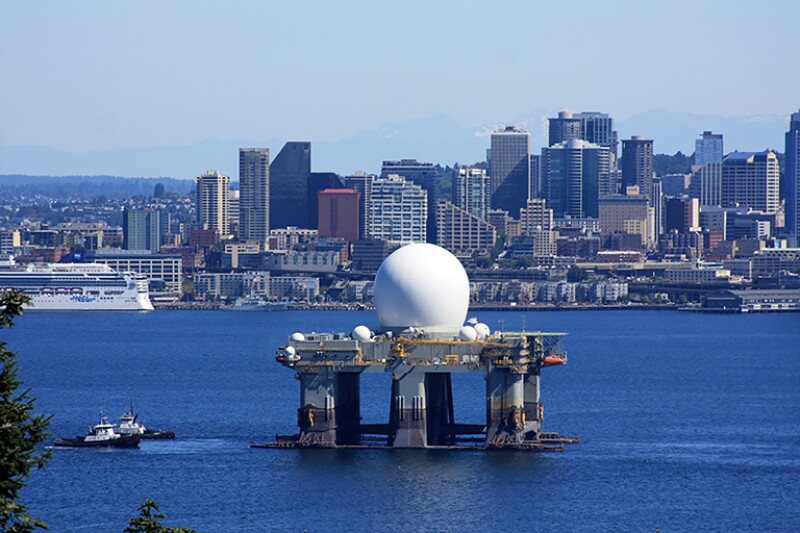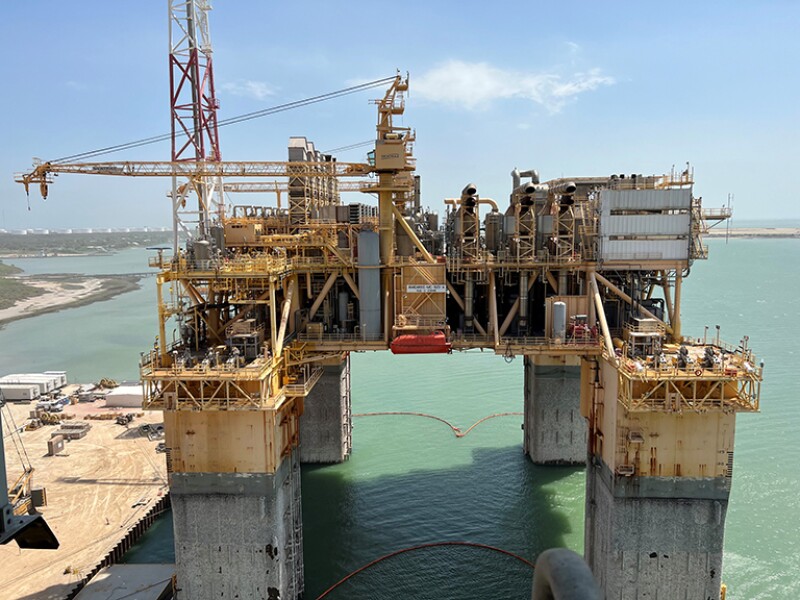Reduce. Reuse. Recycle. We’ve all heard the mantra and likely recall it as our grade school introduction to the world of recycling. On a personal level, that meant collecting tin cans, flattening cardboard, or gathering plastic or glass receptacles. Many of these waste products return to industry and reemerge as something new and are kept out of a landfill, at least temporarily. When it comes to recycling in the oil and gas industry, many have looked at assets that have reached their end of life in one service and attempted to repurpose them for another.
Offshore rigs have been sold out of the industry to become everything from early warning radar stations for the US military (see the SBX-1) to potential offshore launch pads for Elon Musk’s SpaceX program and beyond. Many offshore platforms in the Gulf of Mexico (GOM) either find their way to the scrap yard or into the rigs-to-reefs program, which reuses old, fixed platform jackets as fresh ecosystems for marine life.
However, something that is often talked about but rarely occurs is the reuse of an existing, but idled, production platform on a new field. This appears to be the fate of Independence Hub (IHub)—the floating centerpiece to an ambitious Anadarko Petroleum-led $2-billion deepwater GOM project that aligned several different players and various natural gas discoveries in the mid-2000s (OTC 31155). The last well at IHub ceased production in December 2015, after just 8-plus years of operation. The facility hosted produced volumes of more than 1.3 Tcf of gas, exceeding initial projections for the project by more than 30%. IHub was idled soon after and ultimately decommissioned in 2019.

A New Lease on Life
In May, offshore producer LLOG acquired IHub; it plans to modify the deep-draft, semisubmersible platform to develop a pair of discoveries in the Keathley Canyon area of the GOM. The reborn platform will be renamed Salamanca and will host oil and gas production from the Leon find in Keathley Canyon Blocks 642, 643, 686, and 687 and the Castile discovery (formerly Moccasin) in Block 736. As currently envisaged, two wells from Leon and one well from Castile will be tied back to the unit at its future installation site in Block 689 in 6,400 ft of water. Initial production from the joint development is expected in mid-2025.
“By modifying a previously built production unit compared with constructing a new facility, we are able to reduce significantly the time and cost to bring these discoveries online,” said Philip LeJeune (according to his LinkedIn), president and chief executive of LLOG. “This development will add a significant new source of needed domestic oil and natural gas production when it comes online.”
IHub will be refurbished to have a capacity of 60,000 B/D of oil and 40 MMcf/D of natural gas. The facility was originally equipped with a two-level production deck capable of processing 5,000 B/D of condensate and 1 Bcf/D of natural gas. The buildout to include oil processing on the once all-gas system will require extensive work on the topsides of the unit. However, LLOG maintains that by modifying a previously built production unit, the time and cost to refurbish the unit are greatly reduced compared with construction of a new facility.
“We took a broad approach and looked at our options on the table for development,” said Eric Zimmerman, chief operating officer at LLOG. “We didn’t allow ourselves to be cornered into a single development option. When we looked at all the scenarios, we thought that IHub still had some good life left on it. We investigated it and found it to be a good solution and a solution that could help reduce cycle time, reduce the capital exposure, and reduce some carbon exposure as well.”
The project also has a positive environmental impact by the reuse of an existing unit compared with abandonment of the unit and is expected to result in approximately a 70% reduction in emissions compared to the construction of a new production facility.
LLOG has not revealed who will do the conversion and refurbishment work on Salamanca, but the facility is currently quayside at Kiewit Offshore Services (KOS) in Ingleside, Texas. The fabricator is familiar with the system. KOS was responsible for the topsides construction and hull integration of the newly minted IHub in the mid‑2000s.
“It is going to essentially be all new topsides,” added Zimmerman. “We anticipate getting to work very, very soon. One of our goals here is to reduce cycle time.”
The unit is being financed through an ownership arrangement with investment vehicles managed by ArcLight Capital Partners, an energy‑focused private-equity firm based in Boston, Massachusetts. ArcLight has been active in deals involving GOM assets, including the recent purchase of Murphy’s 50% stake in the King’s Quay FPS.
Leon is a discovery drilled by Repsol in late 2014 in Keathley Canyon Block 642 about 250 miles southwest of New Orleans in 6,000 ft of water. The discovery well was drilled to a total depth of about 32,000 ft and encountered nearly 700 ft of high-quality net oil pay in multiple sands in the Lower Tertiary.
The Castile discovery was drilled on nearby Block 736 in more than 6,500 ft of water to a total of more than 31,000 ft and encountered nearly 400 ft of high-quality net oil pay, also in the Lower Tertiary.
Under the terms of an asset exchange agreement between LLOG and Repsol signed in April 2019, LLOG became the operator with a 33% working interest in the well while Repsol moved forward with a 50% stake. For Castile, Repsol acquired a 30% interest in the discovery, and LLOG will retain a 31.35% working interest and operatorship.
Reuse Is Rare in the GOM
“Designed for reuse” was often used as a selling point for various offshore production platform designs but it rarely ever happened in the GOM. What did happen on occasion was the conversion of a floating offshore drilling rig to a production facility, which is what occurred when Enserch Exploration bought the Glomar Biscay 1 semisubmersible in 1992 and converted it into the Enserch Garden Banks production unit for use on its Cooper field in Garden Banks Block 388 (OTC 7846). Before that, Placid Oil converted the Penrod 72 into a production facility—the first-ever floating production system (FPS) in the GOM (OTC 5845). It was installed in Green Canyon Block 29 in 1986 and was decommissioned 2 years later. The Placid FPS was later reused on Petrobras’ Albacora field offshore Brazil.
“I think in the Gulf of Mexico, companies have actually done a pretty good job of keeping facilities pretty busy and full for a long period of time,” said Zimmerman. “So, most of the facilities that have gone out into the Gulf have had long lives in their locations. Many have even gone through life extensions for most of those facilities. You haven’t seen, especially in the Gulf of Mexico, all that many floating production facilities decommissioned, period. When they have been decommissioned, they’ve been decommissioned after quite a life span. Not anything too truncated, like you might argue IHub was.”
While LLOG has commented that regulatory approvals required to proceed with the development have been received, one hurdle for reuse of an older FPS in the GOM has been the series of metaocean criteria changes made by regulators following hurricanes Katrina and Rita in 2005. The changes were under consideration as IHub came online in the summer of 2007, so the facility was not subject to the new rules, which included requiring greater freeboard to clear 100‑year storm waves and revised riser and mooring tensions. It is unclear what changes, if any, must be made to the IHub hull to meet the new requirements.
“There will need to be modifications to meet all of the current standards, but we felt the facility lent itself well to adaption for the current standards,” said Zimmerman.
Both Katrina and Rita ripped through the GOM oil patch as Category 5 storms just weeks apart in 2005, destroying more than 100 offshore platforms including Chevron’s Typhoon tension-leg platform, which was found ripped from its tendons and floating upside down (OTC 18414).
Gas exports from Salamanca will be tied back 30 miles to the Williams-operated Keathley Canyon Connector (KCC) pipeline. The KCC moves gas from the deepwater GOM to an onshore gas processing plant in Larose, Louisiana, and gas liquids fractionation at the Paradis facility in Louisiana. A deal for oil export from the facility has yet to be announced.
For Further Reading
OTC 31155 A Critical Assessment of Deepwater Gulf of Mexico Floating Platform Engineering, Procurement, Construction, and Installation EPCI Contracting Strategies and Cycle Times by Richard B. D’Souza and Shiladitya Basu, KBR.
OTC 18721 Independence Project Overview—A Producer’s Perspective by Susan M. Holley and Robert D. Abendschein, Anadarko Petroleum.
OTC 7846 Garden Banks 388 Floating Production Vessel Selection and Conversion by M.J. Taylor, H.E. McBee, L.S. Edelblum, A.D. Henderson, Aker Omega; and D.C. Scovell, Enserch Exploration.
OTC 5845 Modification of the Penrod 72 for Green Canyon Block 29 Development by J.J. Filson, A.D. Henderson, and L.S. Edelblum, Omega Marine Engineering Systems Inc.; and R.D. Pickard, Placid Oil Co.
OTC 18414 Observations of Hurricane Impacts on Deepwater Facilities by D.J. Wisch, Chevron.


